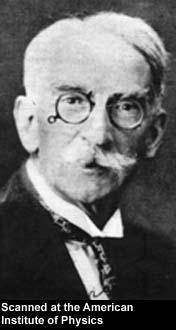
BIOGRAPHY OF PIERRE-ERNEST WEISS (1865 - 1940)
-
born March 25, 1865, Mulhouse, France.
died Oct. 24, 1940, Lyon, France.
|
|
BIOGRAPHY OF PIERRE-ERNEST WEISS (1865 - 1940)
died Oct. 24, 1940, Lyon, France. |
Pierre-Ernest Weiss (1865–1940), the french physicist, one of the founders of the physics of magnetism.
From 1883 to 1886 he studied Mechanical Engineering at the ETH in Zurich and in 1887 he went to the Ecole Normale Superieure in Paris where he became "agrege" in 1893. As a student of Jules Violle and Marcel Brillouin, in 1896, he presented his thesis at the Faculte des Sciences in Paris when he was Maitre de Conferences at Rennes. His thesis was devoted to the magnetic properties of magnetite and iron-antimony alloys. In this work he established for the first time, the relation between magnetisation and crystal symmetry. Pierre Weiss thus received a formation in both pure and applied science.
From 1899 to 1902 he was Maitre de Conferences at Lyon and in 1902 he became professor and director of the Physics Laboratory at the ETH in Zurich. It was here in 1906-1907 that he formulated the MOLECULAR FIELD hypothesis. He was the first who proposed to subdivide ferromagnetic materials into elementary domains (Weiss or magnetic domains). Weiss domains are small areas in a crystal structure of a ferromagnetic material with uniformly oriented magnetic momenta.
By nature the Weiss domains are magnetized to the full saturation. The boundaries between the domains are called Bloch walls.
Weiss discovered in 1907 that the magnetic moment of atoms ("elementary magnets") of ferromagnetic materials become oriented, even without an external magnetic field. The size of these oriented domains is in the range of 10-3 to 10-5 mm including a volume of about 106 to 109 atoms. The orientation is related to the crystal structure of the material.
In 1911, based on his experimental studies, he suggested the existence of the magneton (Weiss magneton), as a magnetic equivalent of the electron and a basic constituent of matter. The existence of this natural unit for the magnetic moment was not justified by quantum theory. Quantum mechanics defined a theoretical notion of the magneton related to universal constants (the Bohr magneton defined by Pauli in 1920).
The Curie-Weiss law describes the magnetic susceptibility of a ferromagnet in the paramagnetic region above the Curie point:

where

The susceptibility has a singularity at T = Tc. At this temperature and below there exists a spontaneous magnetization.
In many materials the Curie-Weiss law fails to describe the susceptibility in the immediate vicinity of the Curie point, since it is based on a mean-field approximation. Instead, there is a critical behavior of the form

with the critical exponent  . However, at temperatures
. However, at temperatures  the expression of the Curie-Weiss law still holds, but with
the expression of the Curie-Weiss law still holds, but with  representing a temperature which is somewhat higher than the actual Curie temperature.
representing a temperature which is somewhat higher than the actual Curie temperature.
Pierre Weiss designed and constructed many types of apparatus including high field electromagnets. With A. Cotton he worked on the project of the high field Bellevue electromagnet.
In 1918 Pierre Weiss went to Strasbourg where he founded and directed for twenty years a magnetism Laboratory. In his thesis in 1932 carried out in this laboratory, Louis Neel established the basic aspects of antiferromagnetism.
Pierre Weiss became a member of the Academie des Sciences in 1926. He was responsible for the first International Conference on Magnetism held in Strasbourg in May 1939.
| Magnetic states |
| diamagnetism – superdiamagnetism – paramagnetism – superparamagnetism – ferromagnetism – antiferromagnetism – ferrimagnetism – metamagnetism – spin glass |